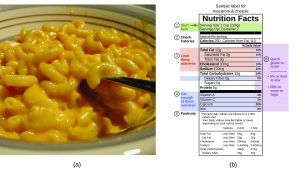Calories: Energy Units
Energy is a quantity that describes the ability to supply heat or perform work. It requires units just like any other quantity, such as mass or volume. There are two common units for energy:
- joule (abbreviated J): 1 joule is defined as the amount of energy used when a force of 1 newton moves an object 1 meter
- calorie (with a lowercase “c,” abbreviated cal)
- 1 calorie is the amount of energy needed to warm 1 g of water by 1 ºC
- 1 calorie is equal to 4.184 J
- Calorie (with a capital “C,” abbreviated Cal)
- 1 Calorie is the amount of energy needed to heat 1 kg of water by 1 °C
- 1 Calorie is equal to 1000 calories
- 1 Calorie is also equal to 1 kcal (because using the metric prefix “kilo-“: 1 kcal = 1000 cal)
Although the joule is the proper SI unit for energy, we will use the calorie or the kilocalorie (or Calorie) in this chapter because they are widely used to describe energies of food and on nutrition labels.
Calories and Food
The food in our diet provides the energy our bodies need to function properly. The energy contained in food could be expressed in joules or calories, but the food industry prefers to use the kilocalorie and refers to it as the Calorie (with a capital C). The calorie is a rather small quantity, so it is inconvenient to use the calorie to describe energy content of foods on nutrition labels. For example, a candy bar may provide 120,000 cal of energy, which is much simpler to write as: 120 Cal (nutritional calories).
The average daily energy requirement of an adult is about 2,000–2,500 Calories, which is 2,000,000–2,500,000 calories (with a lowercase c). If we expend the same amount of energy that our food provides, our body weight remains stable. If we ingest more Calories from food than we expend, however, our bodies store the extra energy in high-energy-density compounds, such as fat, and we gain weight. On the other hand, if we expend more energy than we ingest, we lose weight. Other factors affect our weight as well—genetic, metabolic, behavioral, environmental, cultural factors—but dietary habits are among the most important.
The three main macronutrients in food are proteins, carbohydrates, and fats. All carbohydrates supply approximately 4 Cal/g. Proteins, the building blocks of structural tissues like muscle and skin, also supply about 4 Cal/g. Other important energy sources in our diet are fats. Fats provide even more energy per gram, about 9 Cal/g. Nutritional labels on food packages show the caloric content of one serving of the food, as well as the breakdown into Calories from each of the three macronutrients.

The total Calories per serving of a food is listed near the top of the nutrition label. For the example shown in part (b) of the figure above, the total energy per 228-g portion is calculated by:
(5 g protein × 4 Cal/g) + (31 g carb × 4 Cal/g) + (12 g fat × 9 Cal/g) = 252 Cal
Calculating Total Calories Example
An 8 oz serving of whole milk has 8.0 g of fat, 8.0 g of protein, and 13 g of carbohydrates. How many Calories does it contain?
Solution
The caloric content of fat is 9 Cal/g. The caloric content of both proteins and carbohydrates is 4 Cal/g. To calculate the total calories in one serving, multiply the correct caloric content value by the grams of each food type:
(8.0 g fat × 9 Cal/g) + (8.0 g protein × 4 Cal/g) + (13 g carbs × 4 Cal/g) = 156 Cal
The final answer is 156 Cal.
Measuring Nutritional Calories
So, you can use food labels to count your Calories. But where do the values come from? And how accurate are they? The caloric content of foods can be determined by using bomb calorimetry; that is, by burning the food and measuring the energy it contains. A sample of food is weighed, mixed in a blender, freeze-dried, ground into powder, and formed into a pellet. The pellet is burned inside a bomb calorimeter, and the measured temperature change is converted into energy per gram of food.
Today, the caloric content on food labels is derived using a method called the Atwater system that uses the average caloric content of the different chemical constituents of food, protein, carbohydrate, and fats. The average amounts are those given in the equation and are derived from the various results given by bomb calorimetry of whole foods. The carbohydrate amount is discounted a certain amount for the fiber content, which is indigestible carbohydrate. To determine the energy content of a food, the quantities of carbohydrate, protein, and fat are each multiplied by the average Calories per gram for each and the products summed to obtain the total energy.
Click on this link to access the US Department of Agriculture (USDA) National Nutrient Database, containing nutritional information on over 8000 foods.
Attributions
This page is based on “Chemistry 2e” by Paul Flowers, Klaus Theopold, Richard Langley, William R. Robinson, PhD, Openstax which is licensed under CC BY 4.0. Access for free at https://openstax.org/books/chemistry-2e/pages/1-introduction
This page is based on “The Basics of General, Organic, and Biological Chemistry” by David W Ball, John W Hill, Rhonda J Scott, Saylor which is licensed under CC BY-NC-SA 4.0. Access for free at http://saylordotorg.github.io/text_the-basics-of-general-organic-and-biological-chemistry/index.html

